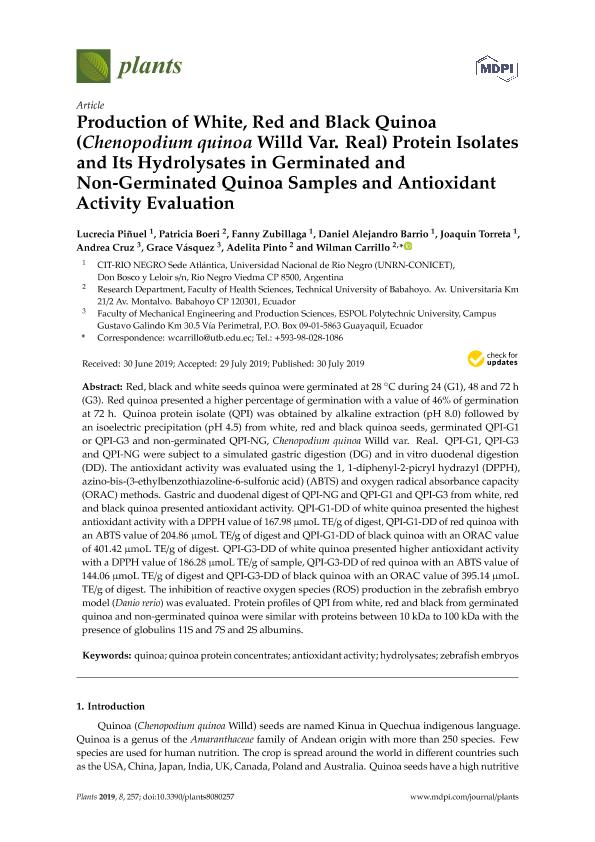Artículo
Production of white, red and black quinoa (Chenopodium quinoa willd var. real) protein isolates and its hydrolysates in germinated and non-germinated quinoa samples and antioxidant activity evaluation
Piñuel, Maria Lucrecia ; Boeri, Patricia; Zubillaga, Fanny; Barrio, Daniel Alejandro
; Boeri, Patricia; Zubillaga, Fanny; Barrio, Daniel Alejandro ; Torreta, Joaquin; Cruz, Andrea; Vásquez, Grace; Pinto, Adelita; Carrillo, Wilman
; Torreta, Joaquin; Cruz, Andrea; Vásquez, Grace; Pinto, Adelita; Carrillo, Wilman
 ; Boeri, Patricia; Zubillaga, Fanny; Barrio, Daniel Alejandro
; Boeri, Patricia; Zubillaga, Fanny; Barrio, Daniel Alejandro ; Torreta, Joaquin; Cruz, Andrea; Vásquez, Grace; Pinto, Adelita; Carrillo, Wilman
; Torreta, Joaquin; Cruz, Andrea; Vásquez, Grace; Pinto, Adelita; Carrillo, Wilman
Fecha de publicación:
30/07/2019
Editorial:
Multidisciplinary Digital Publishing Institute
Revista:
Plants
e-ISSN:
2223-7747
Idioma:
Inglés
Tipo de recurso:
Artículo publicado
Clasificación temática:
Resumen
Red, black and white seeds quinoa were germinated at 28◦ C during 24 (G1), 48 and 72 h (G3). Red quinoa presented a higher percentage of germination with a value of 46% of germination at 72 h. Quinoa protein isolate (QPI) was obtained by alkaline extraction (pH 8.0) followed by an isoelectric precipitation (pH 4.5) from white, red and black quinoa seeds, germinated QPI-G1 or QPI-G3 and non-germinated QPI-NG, Chenopodium quinoa Willd var. Real. QPI-G1, QPI-G3 and QPI-NG were subject to a simulated gastric digestion (DG) and in vitro duodenal digestion (DD). The antioxidant activity was evaluated using the 1, 1-diphenyl-2-picryl hydrazyl (DPPH), azino-bis-(3-ethylbenzothiazoline-6-sulfonic acid) (ABTS) and oxygen radical absorbance capacity (ORAC) methods. Gastric and duodenal digest of QPI-NG and QPI-G1 and QPI-G3 from white, red and black quinoa presented antioxidant activity. QPI-G1-DD of white quinoa presented the highest antioxidant activity with a DPPH value of 167.98 µmoL TE/g of digest, QPI-G1-DD of red quinoa with an ABTS value of 204.86 µmoL TE/g of digest and QPI-G1-DD of black quinoa with an ORAC value of 401.42 µmoL TE/g of digest. QPI-G3-DD of white quinoa presented higher antioxidant activity with a DPPH value of 186.28 µmoL TE/g of sample, QPI-G3-DD of red quinoa with an ABTS value of 144.06 µmoL TE/g of digest and QPI-G3-DD of black quinoa with an ORAC value of 395.14 µmoL TE/g of digest. The inhibition of reactive oxygen species (ROS) production in the zebrafish embryo model (Danio rerio) was evaluated. Protein profiles of QPI from white, red and black from germinated quinoa and non-germinated quinoa were similar with proteins between 10 kDa to 100 kDa with the presence of globulins 11S and 7S and 2S albumins.
Archivos asociados
Licencia
Identificadores
Colecciones
Articulos(SEDE CENTRAL)
Articulos de SEDE CENTRAL
Articulos de SEDE CENTRAL
Citación
Piñuel, Maria Lucrecia; Boeri, Patricia; Zubillaga, Fanny; Barrio, Daniel Alejandro; Torreta, Joaquin; et al.; Production of white, red and black quinoa (Chenopodium quinoa willd var. real) protein isolates and its hydrolysates in germinated and non-germinated quinoa samples and antioxidant activity evaluation; Multidisciplinary Digital Publishing Institute; Plants; 8; 8; 30-7-2019; 1-18
Compartir
Altmétricas
Items relacionados
Mostrando titulos relacionados por título, autor y tema.
-
Garcia, Maria Elena; Varela, Rodolfo Omar del Valle ; Reyes, N. J. Fernando; Prado, Fernando Eduardo ; González, Juan Antonio (Fundación Miguel Lillo, 2011-05)
-
González, Juan A.; Ponessa, Graciela I.; Buedo, Sebastia. E.; Mercado, Maria Ines ; Prado, Fernando Eduardo (Fundación Miguel Lillo, 2014)
-
González, Juan Antonio; Martín, Guillermo O.; Bruno, Marcela; Prado, Fernando Eduardo (Fundación Miguel Lillo, 2016-10)



